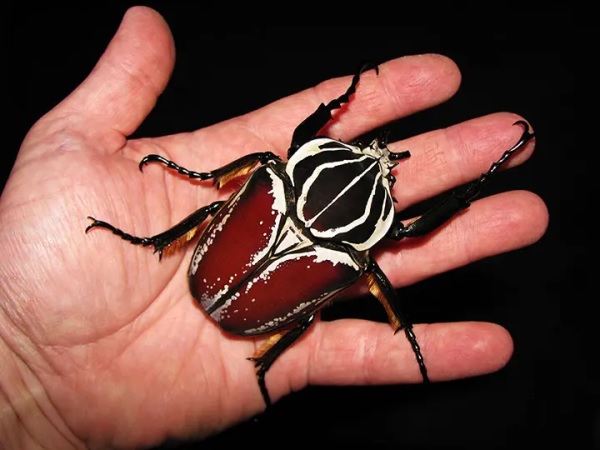
You’ve dealt with whiteflies, gnats, flies, aphids, and so much more in your backyard garden, but there are some insects out there that can be truly horrifying. Meet the Goliath beetle! This insect is a standout in the world of insects, and not just because of its massive size. It’s well known for being the largest beetle in the world, but Goliath beetles deserve to be recognized for more than their size.
Goliath beetles are a group of five beetles, making them a small portion of the 35,000 scarabs and beetles alive today. Goliathus goliatus is the most well-known of all the Goliath beetles, but all of them share vivid coloration and impressive size that are the hallmarks of this species. The largest beetles can grow up to 4.3 inches in length, and their colors range from generic blacks, browns, and grays to vibrant shades of green, blue, or red.
From birth to death, Goliath beetles go through a complete metamorphosis. This process consists of four stages: egg, larva, pupa, then adult. After emerging from an egg, Goliath beetle larvae grow to the size of an adult human palm. Goliath beetle larvae are well known for their immense appetite, primarily feeding on decaying wood and plant matter. Their diet, rich in cellulose, is broken down by specialized gut bacteria, allowing the larvae to thrive in their nutrient-rich environment. These larvae can take several years to reach full maturity, and during this time, they undergo multiple molts, shedding their exoskeletons as they grow. Once fully grown, a Goliath beetle can lift up to 850 times their body weight.
Once the larvae reach their final stage, they dig a chamber in the soil and transform into pupae. Within this pupal stage, they undergo a complete transformation, eventually emerging as stunning adult beetles. Adult Goliath beetles typically live for only a few months, during which they focus on finding a mate to continue the life cycle. Male Goliath beetles have Y-shaped horns on their heads, which they use to fight other males for territory and mates, while female horns have a wedge-shape that is better suited for burrowing and digging.
Due to their incredible size and beauty, Goliath beetles have become popular in the exotic pet trade and insect collecting hobby. Habitat destruction and agriculture combined with the pet trade, have put pressure on their populations in the wild, and most species are now considered vulnerable or endangered. Conservation efforts are being made to protect their natural habitats in Africa and regulate the trade of these magnificent creatures.
The next time you’re complaining about whiteflies and aphids, keep things in perspective and be thankful that you don’t have to do pest control on beetles the size of your hand!
Related Articles & Free Email Newsletter Sign Up
How to Eliminate Creepy-Crawlies In Your Firewood
How to Identify Spider Mites That are Eating Your Plants
What’s This Bug? The Dreaded Spotted Lanternfly (Lycorma delicatula)




Comment here